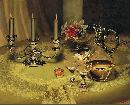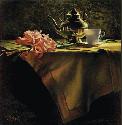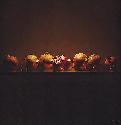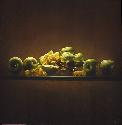
Learn foreign languages while watching your favorite YouTube videos!
The Language learning app is a handy set of tools that will help you improve your language skills by accessing subtitles, a built-in dictionary, and saving words and phrases you want to learn to revise.
Learning foreign languages will be an interesting and exciting experience for you!
Why do I choose to work in classical realistic style?
Artists learn everything they can about other artists' styles and techniques throughout history, filter this information through their own experience and temperament, and generate their own style.
It can take years for an artist to develop a specific style, reflecting his or her artistic range and personal temperament. But, in my opinion, an artist's work must not stop there. Artists have to constantly take on new stylistic challenges. In this sense, I’m not afraid of searching for new ways and means of expression. I’m always trying out new subjects, media, and perspectives - to keep
my work fresh and original.
Some artists find that the emotional impulse drives them to create, and seek to reveal that emotion in their art. Other artists are drawn to innate logic and order; they are likely to take a rational approach to art. Concerning my art, I would say that I’m seeking to find the balance and accord between emotion and rationality in my paintings.
I think that the art with classical or rational tendencies continues to be very popular because
it brings to our busy lives a sense of balance and harmony. With my art I try to persuade the viewers that if we look carefully enough, we can find a certain classical beauty and elegant form in the most ordinary objects and materials. I try to suggest trough my images that perhaps there is a mysterious, underlying order even in our chaotic world.
Back to top
What is Still Life for me?
On definition a Still life is a picture of inanimate objects. It has always been an important formal exercise for an artist. The aim of the artist is to capture volume, texture and color convincingly enough to convey an illusion of reality. I always try to create still lifes that are more than just a picture of objects. I would like my still lifes to have a hidden content, to tell a story or to remind us of life’s brevity.
When I arrange my still lifes, I don’t simply choose attractive or interesting objects to depict, but I choose objects that symbolize aspects of our existence and human presence.
My sill lifes have to look like deserted stage sets in a state of suspended animation - just waiting
for the next act to begin, like someone has just left or someone will just come.
Back to top
The creative process
When I decide to create a still life, I always have a plan in my mind. I always have a screenplay for the story I would like to relate. When the idea is clear, I begin to think about the ways to realize it. When I set the scene, I have to find the best and the only one possible composition which should convey my idea, I have to find the most attractive combination of the objects themselves, their location, the lighting conditions and last but not least - the point of view.
In my opinion, the most important and powerful means for the still life is the light. Some still life artists like to use pompous artificial scenic light, their still lifes look like a stage illuminated by light from above. When I arrange my still lifes I prefer to use light which imitate the natural illumination – like in a late summer afternoon or morning, and sometimes - intimate candle lights. This way I achieve warmer and more intimate atmosphere, the feeling of romantic contemplation or dramatic tension in my still lifes.
For the painting - I use canvas prepared myself with hand made ground coat. Following the technology of the old masters, I made my own recipe for the gesso-ground, based on natural organic substances.
I prefer to paint on black or dark gray background. While I paint, I like the objects in my still lifes to appear from the dark. First I make a precise under painting with acrylic, using a small ordinary brush. Then I continue with oil using airbrush and brush. My latest still lifes are made only with acrylic.
Back to top
I’ve been often asked with question -
How long does it take to paint one still life like this?
The answer I always give is that each painting is different and it depends on the size and the objects. But it is always at the cost of 25 years painting practice, experience and knowledge.
Back to top
When do I decide that the painting is completely ready?
As to me - “That is the question!” It is very important to know when to stop. One painting, especially realistic, could be painted lifetime. You have to believe me that it’s a very big temptation and challenge to paint out to the full the painting (especially when you have the experience and knack to do this). To me each painting is like a child who grows and suddenly it gets its own personality and character. And there comes the moment when you have to respect and follow its own life. The key is to realize where to stop, to overcome the artistic narcissism and desire for a skill demonstration, and to conform to the painting’s life. I’ve been always aspired to keep the painting’s freshness and achieved mood; do not overpaint it. I’ve never had the ambition to achieve a hyper realistic quality in my paintings because I find it senseless for my still lifes. It’s more important for me to attain the mood, atmosphere and to tell the story I would like to share.
Back to top
Biography: She was born in Bulgaria in 1966. From 1980 to 1985 Maria studied painting, printing, sculpture and art composition at the "Tsanko Lavrenov" High School Of Fine Arts, Plovdiv, Bulgaria. In 1985 she continued her art education in the Fine Arts Department of "St. St. Ciril and Methodius" University in Veliko Tarnovo, Bulgaria, specialized in plastic arts and oil painting and graduated from the University with Master of Arts in 1990.
Since 1993 she has worked as a teacher in art composition and painting at the High School Of Fine Arts in Plovdiv for 3 years, and now works full-time on painting in her studio in Plovdiv, Bulgaria.
She has been a member of the Union of the Bulgarian Artists, Plovdiv since 1992.
Besides in the field of Still Life she also works in the field of the abstract art and portrait.
Since 1995 she has been exhibiting her art works exclusively in Art Gallery "Galeriet", Art Gallery "Amare" - Stavanger and Art Gallery "Smiegarden" - Sandnes in Norway.
She has had several personal shows and taken part in many group art exhibitions in Bulgaria and Norway.
SELECTED PERSONAL EXHIBITIONS:
1993 - National Gallery "Zl. Boiadziev", Plovdiv,
Bulgaria
1995 - City Gallery of the Association of Artists in
Plovdiv, Bulgaria
1997 - Art Gallery "Galleriet", Stavanger, Norway
SELECTED GROUP EXHIBITIONS:
Since 1992 - Participation in all art exhibitions of the
Association of Artists in Plovdiv, Bulgaria
1995 - National Art exhibition "Autumn Saloon",
"Shipka 6" Art Gallery, Sofia
1993 - International Art Bienale, Gabrovo, Bulgaria
1994 - National Art Exhibition, Kjustendil, Bulgaria
1995 - National Art Exhibition, Lovetch, Bulgaria
1995 - 2001 - Art Gallery "Galeriet", Art Gallery "Amare" in
Stavanger and Art Gallery "Smiegarden" in
Sandnes, Norway
Country: Bulgaria
E-mail: mariavarbanova@yahoo.com
Site: http://www.mariavarbanova.evro.net


















